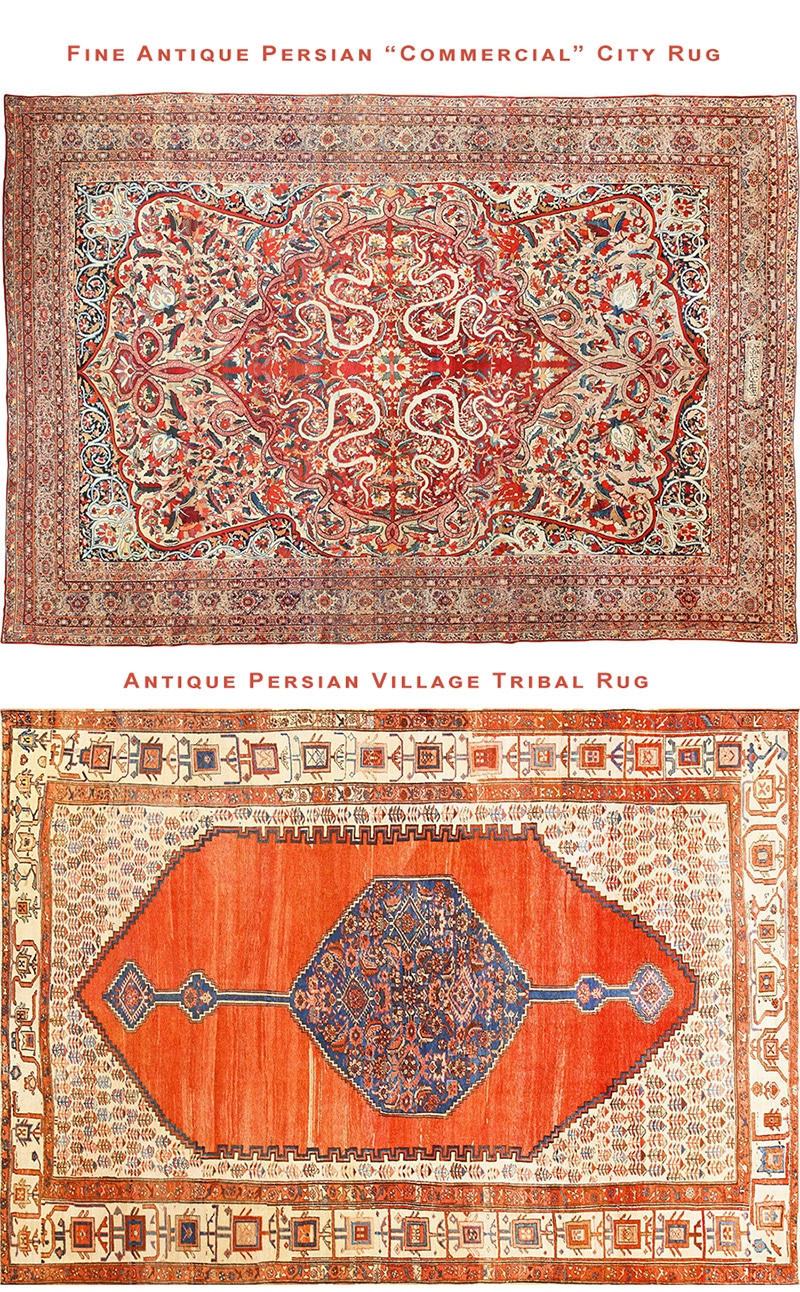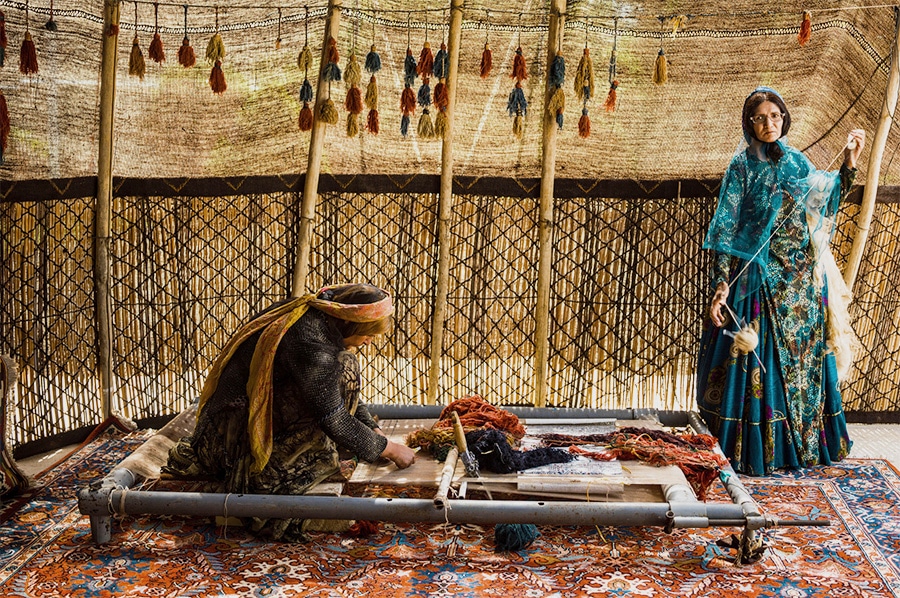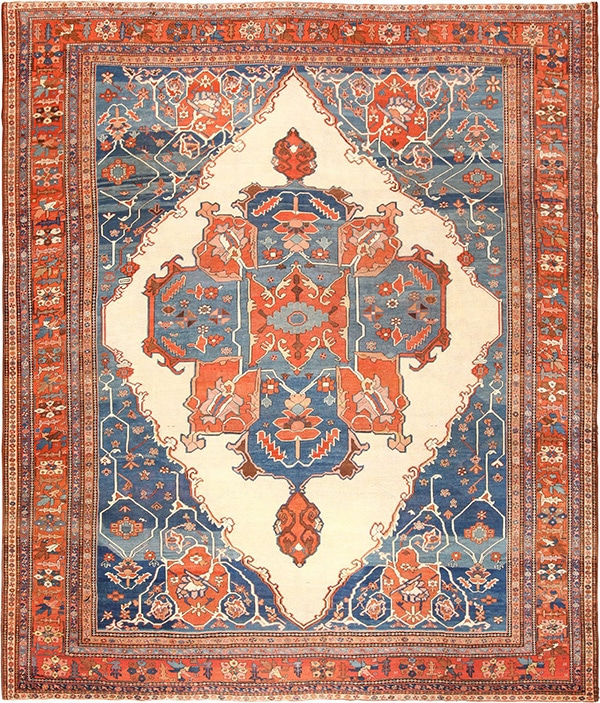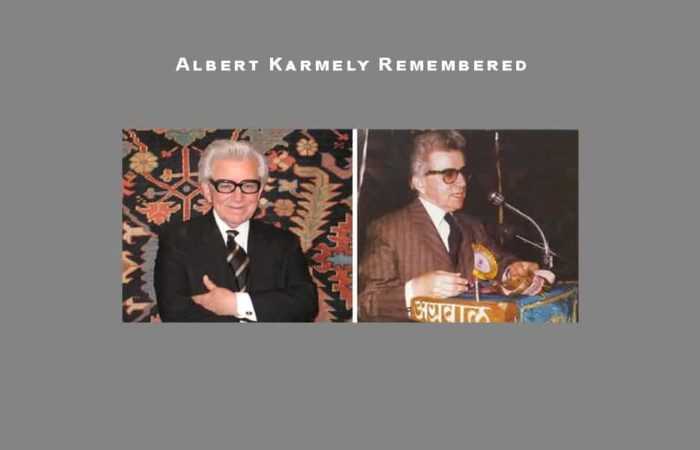Explaining City Rugs vs. Village Rugs From Persia
From the earliest times, the motives or purposes, behind rug production, have been complex. As domestic home furnishings, woven area rugs and carpets must have originated for practical reasons. First for the purposes of comfort and then as decorative objects. Rugs and carpets served to embellish the home in decorative, functional and aesthetic terms.

Persian City Rugs vs. Village Rugs
Over time, the rug weaving techniques and their carpet designs, gradually became more sophisticated. As this trend continued, carpets gradually became objects of luxury and class, indicating the affluence and social standing of their owners. Once this had occurred, i.e. , once the rugs themselves began to function as valuable commodities and social status symbols, their production itself became a means of generating wealth for their manufacturers. Especially in Persian urban city centers of rug production.
The workshops of Persian urban city rugs that could produce the finest quality rugs could also command the highest prices. The city rug producers in Persia, who designed the very finest rugs, acquired reputations of ‘master weavers’. Some of these master rug weavers even began to sign their work.
There has sometimes been a tendency, especially among collectors, to contrast commercial city rug weaving with village and nomadic rug weaving. In this view, the commercial city rug weaving is seen to cater to commercial marketplace demands. In contrast, the work of village or nomadic rug weavers is assumed to have a more genuine cultural and / or aesthetic ‘authenticity’. This is mostly because the village rugs are thought to have been made for the weavers’ own personal use; rather than for sale.

A Persian City Rug Weaver Weaving a Fine Carpet
This is, however, somewhat of a false opposition, as commercial rug production, was, by no means, limited to cities. Village and / or nomadic rug weavers often traded or sold their work as a source of income. It also turns out, that nomadic and village rugs were not only produced by women in individual households. We now know that village tribal rugs were also produced in larger, organized workshops for the bigger, “outside” market orders.

Persian Rug Weavers Weaving a Village Carpet
Also, there is nothing particularly “authentic” about non-urban or village rugs designs. Village and nomadic rug designs often turn out to be far less ancient or traditional than experts have supposed. The Persian commercial urban city rug designs, were, in fact, continually changing ‘improving’ or ‘tweaking’ designs `according to the weavers’ creative impulses.
The same holds true to the urban ‘commercial’ city rug designers. They too may have had long traditions behind them. This is despite them having to respond to the ever changing tastes of the marketplace. In the end, it was the commercial basis of rug production, its need to achieve a successful market share, that guaranteed its high technical and design standards. Only the finest, most creative commercial Iranian city rugs could expect to dominate the marketplace.
Fascinating and Antique Village Rugs from Persia
Like tribal and nomadic Persian rug weaving, a certain romantic charm attaches to the concept of the Persian village rugs. Since they are widely perceived as a form of folk art, village rugs too are often thought to embody notions of cultural authenticity and antiquity.
Nevertheless, they still represent a complex and longstanding relationship with urban commercial rug production in all its design and technical aspects. For like Persian nomadic rugs, the village rug weaving also tend to have more abstract Persian rug designs of purely geometric form or highly geometric versions of floral and animal motifs derived ultimately from the urban rug design repertory.
The village rugs that were woven in Persia are generally produced in smaller, scatter sizes rather than room sizes. Since their designs are bolder and more rectilinear and they tend to be woven more coarsely, with fewer knots per square inch. Although they are generally produced on upright urban style rug looms rather than horizontal looms of nomadic type, the foundation of village rugs may be of wool in the nomadic manner, or it may use cotton like urban rugs, or some combination. At times, village production may be capable of producing larger sized carpets like those of the Heriz, Serapi or Sultanabad rug family.
But despite their larger scale and reliance on urban floral designs of central medallion or allover type, such carpets often retain the more abstract geometric sensibility typical of smaller village rugs. Some Persian village rug productions, however, may be a direct extension of the nearby urban workshops, preserving the very same design and technical standards.
City Rugs vs Village Area Rugs
City rugs and village rugs are two distinct types of handwoven carpets or rugs that originate from different settings and often have unique characteristics. These differences are influenced by the environment in which they are created, the culture of the weavers, and the materials available.
Here’s a comparison of city rugs and village rugs:
- Geographical Origin:
- City Rugs: City rugs are typically produced in urban areas or cities, where there is greater access to resources and market demand. Cities with a rich tradition of rug making, such as Tabriz in Iran or Istanbul in Turkey, are known for their city rugs.
- Village Rugs: Village rugs are woven in rural or village settings, often in more remote and isolated areas. These areas may not have as much access to urban markets and resources.
- Design and Patterns:
- City Rugs: City rugs are often characterized by intricate and elaborate designs. They may feature fine floral patterns, medallions, and highly detailed motifs. These designs are often a reflection of the cosmopolitan nature of the city and the influence of various artistic and cultural elements.
- Village Rugs: Village rugs tend to have simpler, more geometric patterns. The designs are often more traditional and passed down through generations. They may reflect the natural surroundings and daily life in the village.
- Materials:
- City Rugs: City rugs often use high-quality materials, such as silk or fine wool. The choice of materials can be influenced by the availability of resources and the desire to cater to a more discerning market.
- Village Rugs: Village rugs may use more readily available and durable materials. They might be made with coarser wool or other natural fibers.
- Knotting Technique:
- City Rugs: City rugs are often woven using a finer knotting technique, such as the Persian knot (asymmetrical knot) or the Turkish knot (symmetrical knot). This allows for greater detail in the design but can be more time-consuming.
- Village Rugs: Village rugs may use a coarser knotting technique, which is quicker but may not allow for the same level of detail.
- Dyeing Methods:
- City Rugs: City rugs may employ more sophisticated and varied dyeing techniques to achieve intricate and vibrant colors in the design.
- Village Rugs: Village rugs may use more traditional and simpler dyeing methods, resulting in earthier and more muted tones.
- Market Value:
- City Rugs: City rugs, often considered more intricate and refined, tend to have a higher market value and are sought after by collectors and connoisseurs.
- Village Rugs: Village rugs are generally more affordable and may be seen as functional, everyday items.
In summary, city rugs and village rugs each have their own unique charm and characteristics, reflecting the influence of their respective environments and the cultural backgrounds of their weavers. The choice between them often depends on personal preferences, budget, and the intended use of the rug.
This rug blog about city rugs vs. village rugs was published by Nazmiyal Antique Rugs in NYC.




